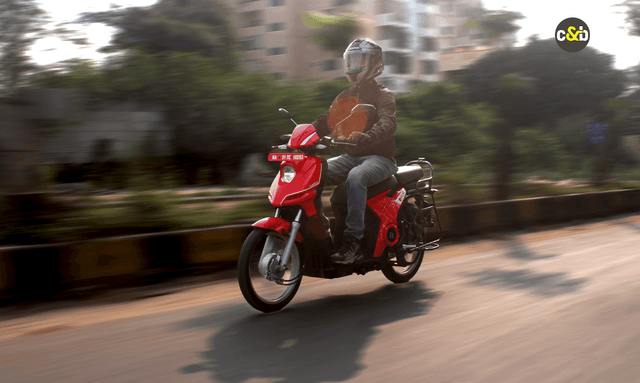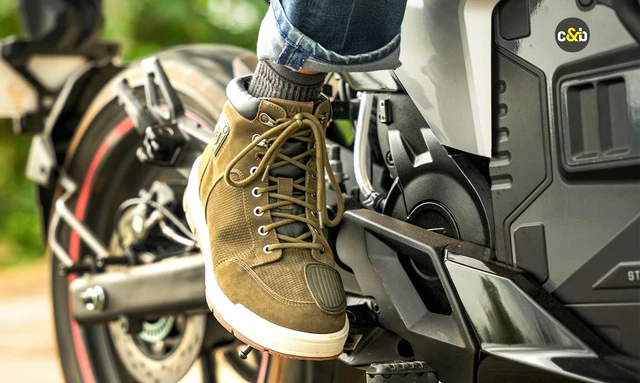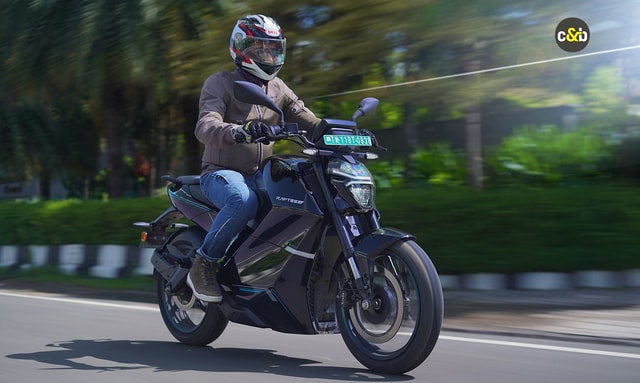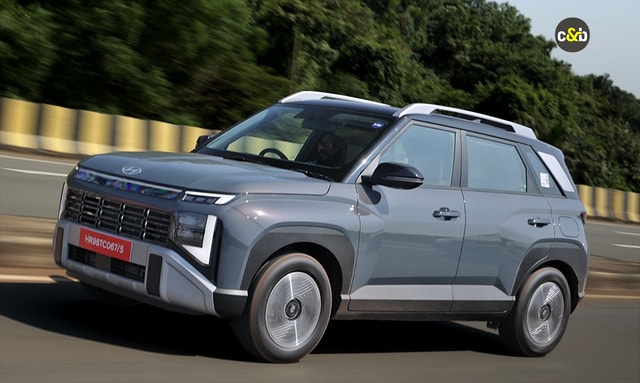Mercedes India CEO Santosh Iyer On EVs, Charging Infra And Future Models

- Mercedes-Benz launched the EQE SUV recently, its third all-electric vehicle for India within a year.
- India MD and CEO Santosh Iyer says relevant charging infrastructure is still a deal breaker in 1 of five prospective customers.
- Brand sees EVs contributing as much as 25 per cent to its total sales in the next 3 to 4 years.
Mercedes-Benz has been at the top of the luxury car game in India for some time now. While one of the first car makers to introduce battery-powered vehicles in India, it is now trying to accelerate luxury EV adoption with its third launch (EQE SUV) in less than a year.
Also Read: Mercedes-Benz EQE SUV Launched In India At Rs 1.39 Crore
Girish Karkera, Editor-in-Chief of carandbike.com, caught up with Mercedes-Benz India MD and CEO Santosh Iyer to get some insights on the business of luxury EVs and the way ahead for the three-pointed star.
Girish Karkera: The EQE SUV is your fourth EV launch in India. What is the biggest difference between when you launched your first EV, the EQC, and now?
Santosh Iyer: I believe the question of whether India is ready for electric vehicles is actually past us. In the last three years, in between we even had the pandemic, there were questions like when will the transition happen or whether it will happen at all. We started with the EQS' localisation (last year). Then we introduced the EQB, for which deliveries started this year. And now we have introduced the EQE SUV. These are still early days. Our total penetration (in the luxury segment) is still four to five per cent. But we have a clear road map of going up to 25 per cent in the next three to four years’ time. We have the infrastructure piece on one side, but on the other side is also the awareness among consumers, the ability to understand electric ecosystem space and adapt to it that I think needs some more time. But with more players coming with more products and industry collaborating, this will accelerate.
Also Read: Mercedes-Benz EQE Review: Is It A Do-It-All Luxury EV?

The EQS sedan is the first all-electric Mercedes to be locally assembled in India.
GK: How different is a customer's journey while acquiring a luxury EV compared to a petrol/diesel car?
SI: There are a lot more questions. Also, a lot of time is spent trying to check the feasibility of charging at home. We have a 20 per cent drop rate with non-feasibility on charging. So, we have customers who want to buy an EV but then we end up seeing that there is no feasibility for home charging at their residence or at their workplace and then they rethink and change their purchase to an ICE. Sometimes housing societies are not aligned. So, we have a lot of those challenges which are not there for the combustion engine where you can just walk in, buy a car and drive it home.
GK: So, is it more difficult to sell an EV?
SI: You can say that but not from a product perspective. Most information is available online. But it's the charging ecosystem feasibility that is a challenge. The lead time to convert is a bit more compared to an ICE car.
Also Read: Why Mercedes’ Astonishing Maybach 6 EV Concept Is Coming To India In 2023
GK: There was an interesting point you made about how Mercedes-Benz is also looking at educating chauffeurs. How important is that?
SI: Firstly, there are a couple of myths around charging. First, the customer and even the chauffeur thinks that if they park the car for some time, the charge will go down like a mobile phone’s, which is not the case. Second, there is the anxiety of the next available charger. So, even if it is in the 40 to 60 per cent range, most want to recharge the car. In an ICE car, even with a quarter tank of fuel, people continue driving because of easy availability of fuel stations. But they don't want to take that risk with an EV.
Additionally, for the chauffeurs, these cars are loaded with ‘hyperscreens’ and many tactile buttons. It's intimidating to a large number of them. So, we have to educate them that these are simple and intuitive. We have to engage with them on some of these topics.
GK: And also about the life of an EV?
SI: When we say the battery warranty is eight years, does that mean the car will die after eight years? No. The car can last 15-20 years. The tendency to compare a phone is so huge that some make the mistake of comparing the battery of a car to the battery of a smartphone. So, perception challenges are aplenty.
GK: What about the bane of charging time? It is still a lot compared to refuelling an ICE car?
SI: Range anxiety more or less with luxury cars is not a problem because most of them tend to go 400-500 kilometres. I read a report that said that if the time taken to charge a vehicle is more than half an hour nobody likes it. I say that on long distances, you always take a break. If I can give my personal example, I travel to Hyderabad in a GLS. I have a fixed fuel station where I stop, and my family has a quick snack while I go to that fuel station. I have to stand there when this guy is filling fuel and I always have to go back to my family. By the time they're done with the snack, then I have to eat and they wait. In an EV it's much easier. You do your snacking and leave the car at the charging station unattended.

The EQE SUV is being shipped into India as a full import from the US.
So, a half an hour break on a distance of 600-700 kilometres is nothing.
In the city, if the charging option is available at home or office, once in three or four days, you keep it for overnight charge and your car is done. So, technically, intracity charging is not a major hassle for our segment of customers because they have access to charging at home or at the workplace. In inter-city, half an hour is a reasonable time for anybody to take a short break from driving and then resume.
Also Read: Mercedes-Maybach EQS 680 Super-Luxury SUV Debuts; Will Have Range Of Up To 600 km
GK: Typically, Mercedes owners in India are chauffeur-driven. Do electric vehicles bring in a new breed of owners who’d rather drive themselves?
SI: I remember we had removed the memory package on the driver’s seat and I got quite a backlash from customers. Today, it is standard in all our cars. If they don't drive, they won't need a front seat memory package. Not only do they drive themselves, but their spouses and kids drive the car, too. There are multiple people using the car. I would say Mercedes-Benz customers love to drive, on weekends if not on weekdays as they manage multiple things. They generally employ drivers for ease of parking, etc.
GK: You have a well-specced EQE SUV in India, but why have you left out some cool extras such as rear-wheel steer?
SI: We have to maintain the differentiation with the next model in the range, which is the EQS. It has a rear wheel steering and rear entertainment package.
GK: Will we see the EQC or any other car returning to bridge the gap between EQB and EQS?
SI: There is no EQC at this stage and the EQB, at Rs 80 lakh, is great value for a seven-seater. Our global portfolio includes everything from the EQA to the EQS, so the possibility is there. But at the end of the day, simply bringing all the products here is not the strategy. There is no urgency. We need to get some of the basics and customer acceptance right. Our advantage is that the entire portfolio is there. We will bring more EVs at the right time.
Trending News
 1 min readTop 5 Sports Bikes Under Rs. 2 Lakh
1 min readTop 5 Sports Bikes Under Rs. 2 Lakh
Latest News
 car&bike Team | Nov 17, 2025KTM 390 Adventure, Adventure X Prices Hiked By Up To Rs 27,000The hike in prices is likely due to the brand no longer absorbing the increased cost of the models post-GST 2.0.1 min read
car&bike Team | Nov 17, 2025KTM 390 Adventure, Adventure X Prices Hiked By Up To Rs 27,000The hike in prices is likely due to the brand no longer absorbing the increased cost of the models post-GST 2.0.1 min read car&bike Team | Nov 17, 2025Top 5 Sports Bikes Under Rs. 2 LakhLooking for a sport bike under Rs. 2 lakh? Here’s our pick of the top 5 which will give you an entertaining ride.1 min read
car&bike Team | Nov 17, 2025Top 5 Sports Bikes Under Rs. 2 LakhLooking for a sport bike under Rs. 2 lakh? Here’s our pick of the top 5 which will give you an entertaining ride.1 min read Janak Sorap | Nov 17, 2025Hero Xtreme 160R 4V Combat Edition Unveiled; Gets Ride Modes, Cruise Control and More!While Hero has disclosed the new variant on its social media platform and website, the prices haven’t been announced yet.1 min read
Janak Sorap | Nov 17, 2025Hero Xtreme 160R 4V Combat Edition Unveiled; Gets Ride Modes, Cruise Control and More!While Hero has disclosed the new variant on its social media platform and website, the prices haven’t been announced yet.1 min read car&bike Team | Nov 17, 2025CNG Supply In Mumbai Disrupted Due To Damaged GAIL PipelineCNG/PNG supplier Mahanagar Gas said that CNG supplies across Mumbai, Navi Mumbai & Thane could be affected till supply to its City Gate Station in Wadala is restored.1 min read
car&bike Team | Nov 17, 2025CNG Supply In Mumbai Disrupted Due To Damaged GAIL PipelineCNG/PNG supplier Mahanagar Gas said that CNG supplies across Mumbai, Navi Mumbai & Thane could be affected till supply to its City Gate Station in Wadala is restored.1 min read car&bike Team | Nov 17, 2025Maruti Suzuki Recalls Over 30,000 Units Of Grand Vitara Over Faulty Fuel GaugeUnits affected were manufactured between December 9, 2024 and April 29, 2025.2 mins read
car&bike Team | Nov 17, 2025Maruti Suzuki Recalls Over 30,000 Units Of Grand Vitara Over Faulty Fuel GaugeUnits affected were manufactured between December 9, 2024 and April 29, 2025.2 mins read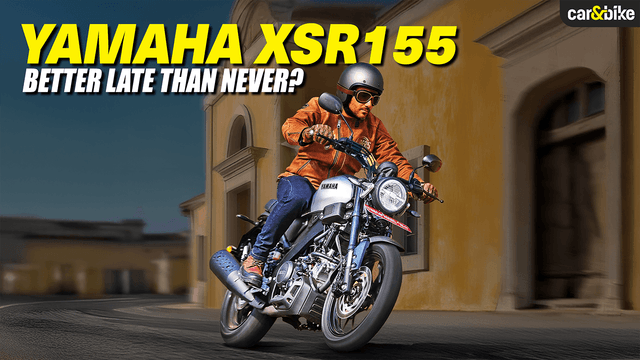 Preetam Bora | Nov 16, 2025Opinion: What’s The Big Deal About The Yamaha XSR155?The Yamaha XSR155 is finally here. Better late than never – but does it have what it takes to be the next big Yamaha success story? Will it follow the Yamaha R15’s winning streak, or carve out the kind of legacy the RX100 once owned?1 min read
Preetam Bora | Nov 16, 2025Opinion: What’s The Big Deal About The Yamaha XSR155?The Yamaha XSR155 is finally here. Better late than never – but does it have what it takes to be the next big Yamaha success story? Will it follow the Yamaha R15’s winning streak, or carve out the kind of legacy the RX100 once owned?1 min read














































































































































